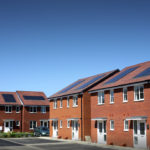Stuart Nicholson, Roof Systems Director at Marley, discusses the latest innovations in solar PV that could help local authorities tackle fuel poverty and cut carbon emissions.
For the first time since the Code for Sustainable Homes scheme was dropped back in 2015, it seems there is a strong Government commitment towards driving sustainability in UK housing. As well as setting a legal target to reduce greenhouse gas emissions to net zero by 2050, the UK Government has outlined a path to achieve this with the 2025 Future Homes Standard and also the Green Growth Challenge to halve energy use in buildings by 2030.
Although, at the time of writing, we are still waiting for the results of the Future Homes Standard consultation, it looks likely that the Government will pursue the more ambitious of the two options. This would require a 31% reduction in carbon emissions and the introduction of carbon saving technology, such as Solar PV, on all new homes by 2025.
Solar PV is a very effective way of reducing carbon emissions and improving the SAP rating of a property. Indeed, it proved to be a popular and successful sustainability initiative for local authorities and social housing providers between 2010 and 2012, when it was driven by generous grant systems such as Feed in Tariffs and also regulatory pressures from the Code for Sustainable Homes. However, the Housing 2050 report (Suss Housing) found that unfortunately, investment in renewable electricity in social homes had declined since 2012/13, due to a lack of funding schemes.
However, now, ongoing concerns about fuel poverty, the forthcoming Future Homes Standard, and new funding in the form of the Local Authority Delivery (LAD) scheme, is driving renewed interest by local authorities and housing associations in solar PV. Together with new innovations that make it easier to fit and more aesthetically appealing, PV is once again emerging as an attractive carbon reduction method that can also save landlords and tenants money.
Reducing household electricity bills
The Energy Savings Trust estimates that installing solar panels to a roof space can reduce a household electricity bill by over £250 per annum, as well as helping to drastically cut the carbon footprint. This can help provide financial savings for the landlord and the tenant. For example, the social housing provider can install the PV panels and then sell tenants the electricity generated at a low rate, tackling both carbon reduction and fuel poverty at the same time. In fact, the Housing 2050 report found that reducing fuel poverty was now one of the biggest drivers for social landlords installing renewable energy systems.
Unlike some other energy efficiency measures, such as insulation or double-glazing, solar PV can also be installed with minimal disruption to tenants and the cost of installation has reduced significantly over the past five years.
As well as becoming more cost-effective, solar PV technology has also seen some huge design improvements in recent years. When people think about solar panels on roofs, they automatically think of the quite obtrusive panels that sit over the top of the roof tiles. These are very effective but are not always that easy for housing providers to get installed, particularly on retrofit projects. It can also be difficult to get them to blend in with surrounding roofscapes.
Solar PV tiles
A new type of solar PV system is now available which significantly improves both installation and aesthetics. The new Marley SolarTile is a flat PV panel that actually integrates in with the rest of the roof tiles — it effectively replaces a section of the roof tiles with solar tiles, acting both as a roof covering and a means of generating electricity. The advantage is that they can be integrated with any of Marley’s existing tiles — concrete, clay or slate, so, housing specifiers can incorporate solar PV as a seamless part of the roof design, with no visible fixings.
This also has clear advantages for housing associations and local authorities looking to retrofit renewable technology on existing social homes, as Marley SolarTile can simply be used to replace a section of tiles on an existing roof. Another big advantage is that housing providers do not need to pay for a PV specialist to install the system, as a roofing contractor can do the job. The solution also offers excellent wind and fire resistance, backed up by a 15-year guarantee, for extra peace of mind.
There is no doubt that 2020 has been a testing year for all social housing providers, with unprecedented pressures on budgets and resources. Delivering sustainable, quality housing in a cost-effective way is a huge challenge for the sector. Therefore, the inclusion of solar PV in the Green Homes Grant Scheme for local authorities (LAD) is welcome news, offering a great opportunity for the social housing sector to take advantage of the type of funding that has not been available to them for years.
The social housing sector has always been at the forefront of sustainable innovation and the houses being built today will be the net zero carbon homes of the future in 2050. Incorporating renewable technology now, alongside improvements to energy efficiency and the building fabric, will help local authorities to significantly cut carbon and improve SAP ratings, future proofing homes against climate change and tackling fuel poverty.









